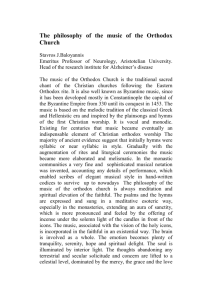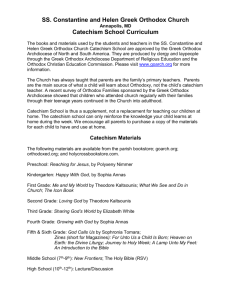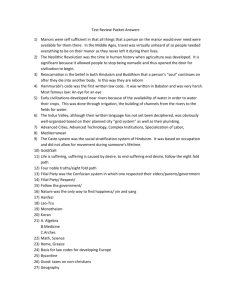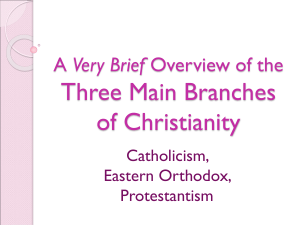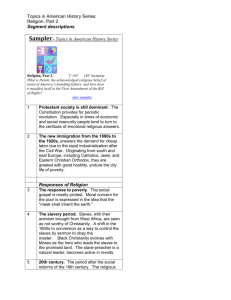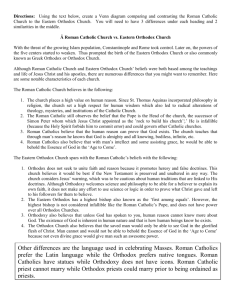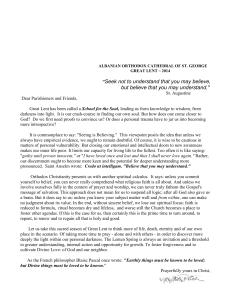Orthodox churches C
advertisement
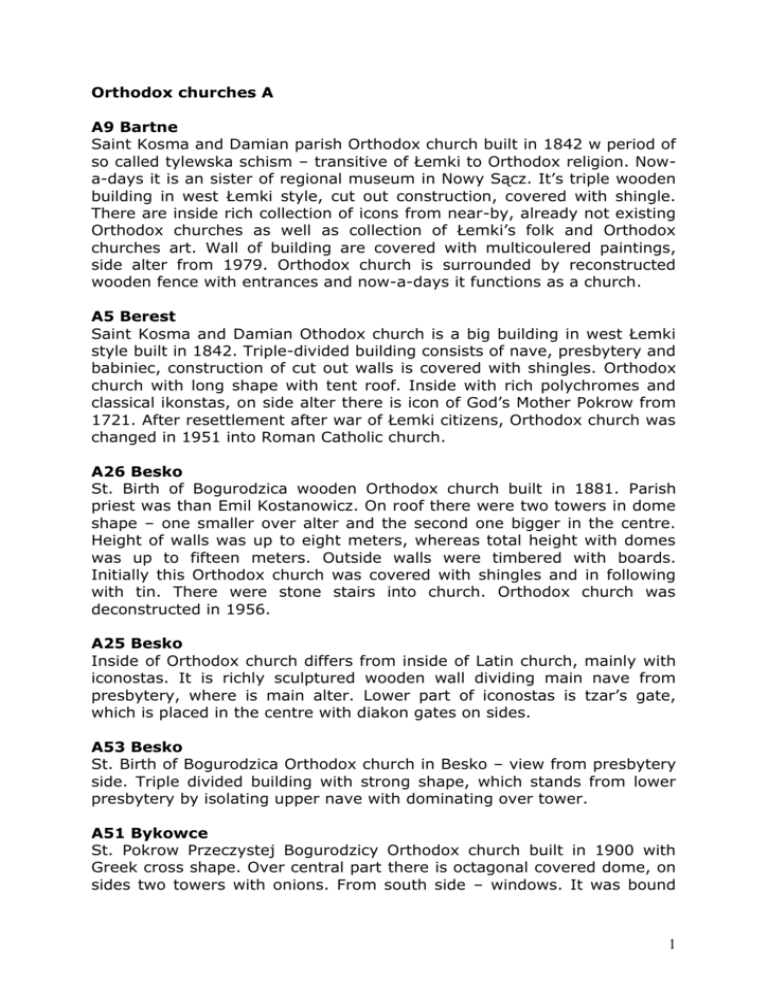
Orthodox churches A A9 Bartne Saint Kosma and Damian parish Orthodox church built in 1842 w period of so called tylewska schism – transitive of Łemki to Orthodox religion. Nowa-days it is an sister of regional museum in Nowy Sącz. It’s triple wooden building in west Łemki style, cut out construction, covered with shingle. There are inside rich collection of icons from near-by, already not existing Orthodox churches as well as collection of Łemki’s folk and Orthodox churches art. Wall of building are covered with multicoulered paintings, side alter from 1979. Orthodox church is surrounded by reconstructed wooden fence with entrances and now-a-days it functions as a church. A5 Berest Saint Kosma and Damian Othodox church is a big building in west Łemki style built in 1842. Triple-divided building consists of nave, presbytery and babiniec, construction of cut out walls is covered with shingles. Orthodox church with long shape with tent roof. Inside with rich polychromes and classical ikonstas, on side alter there is icon of God’s Mother Pokrow from 1721. After resettlement after war of Łemki citizens, Orthodox church was changed in 1951 into Roman Catholic church. A26 Besko St. Birth of Bogurodzica wooden Orthodox church built in 1881. Parish priest was than Emil Kostanowicz. On roof there were two towers in dome shape – one smaller over alter and the second one bigger in the centre. Height of walls was up to eight meters, whereas total height with domes was up to fifteen meters. Outside walls were timbered with boards. Initially this Orthodox church was covered with shingles and in following with tin. There were stone stairs into church. Orthodox church was deconstructed in 1956. A25 Besko Inside of Orthodox church differs from inside of Latin church, mainly with iconostas. It is richly sculptured wooden wall dividing main nave from presbytery, where is main alter. Lower part of iconostas is tzar’s gate, which is placed in the centre with diakon gates on sides. A53 Besko St. Birth of Bogurodzica Orthodox church in Besko – view from presbytery side. Triple divided building with strong shape, which stands from lower presbytery by isolating upper nave with dominating over tower. A51 Bykowce St. Pokrow Przeczystej Bogurodzicy Orthodox church built in 1900 with Greek cross shape. Over central part there is octagonal covered dome, on sides two towers with onions. From south side – windows. It was bound 1 with former beliefs, on north side of church was supposed to exist whole evil. A17 Czarnorzeki Wooden Orthodox church built in 1918 with long shape with inside on square plan. Triple divided emphasizes three covers of roof, different for babiniec, nave and presbytery. Shape of Orthodox church is classical example of tripe divided Łemki Orthodox church, in northern-west type. Roofs are covered with shingles, roof of nave is covered with dome. On sides of babiniec was built tower with gently sloping walls with izbica and baroque dome over. A44 Czerteż Triple divided wooden Greek Orthodox church of St. Przemienienia Pańskiego from 1772 with interesting and two storey belfry from 1887. Orthodox church with specifically beautiful shape, single domed with octagonal dome roof. We can find it on forest hill in Czerteż. Since 1946 it was used by Roman Catholic church, and now-a-days returned to its own function. Inside are preserved lefts of polychromes. A37 Czystohorb Greek Orthodox church of St. Michael Archangel built in 1920. Beginning of XX century brought changes in construction of Orthodox churches. It was started to built churches with triple dome pattern of Galicja Orthodox churches. Hucule style was propagated as Ukrainian national style. Orthodox church in Czystohorbie was an example of such a construction. Wooden building burnt in 1943 because of not intended fire. A36 Czystohorb Before the II World War in Czystohorb village lived 860 inhabitants, including 100 of Gypsies – Greek Catholics. Now-a-days there is only empty place after Orthodox church, chapel and road crosses as well as a few of chyży (Łemki cottage). A14 Deszno Orthodox church in Deszno of St. Birth of God’s Mother built in 1738, it was triple divided building, oriented, in West Łemki type. Surrounded by stone wall of river stones. Through whole XIX century belonged to Potoccy family, in 1895 it’s patron was count Jan Potocki. In post war period Orthodox church was deconstructed. On cemetery in terrain of post Orthodox church are situated two tombs. On one of them is situated steel cross from dome of deconstructed Orthodox church. From Orthodox church of Deszno survived icons being part of presentation in Historical Museum in Sanok. A20 Duszatyn In 1925 was built there Greek Orthodox church of St. Włodzimierz Wielki. It was situated on so called Plain – plain area between now-a-days road 2 and river Osława. It was wooden building built in national Ukrainian style, on Greek cross plan, covered with octagonal dome over nave as well as roof of kalenica over other its parts. Orthodox church was destroyed in ’50 of XX century, now-a-days there is no sign of its existence. A47 Jasiel Greek Catholic wooden Orthodox church of St. Michael Archangel from 1825. In XVIII century in Jasiel existed parochia and in 1785 lived in village 196 Greek Catholics. In 1725 chapel was built there, which in 1825 was reconstructed into wooden Orthodox church. In 1934 Orthodox church was once again reconstructed, brick tower was built. Jasiel village disappeared in 1945/1946, when whole population was moved to CCCP. Orthodox church was destroyed. A49 Karlików Orthodox church of St. Błogosławiona Dziewica Maria Paraskiewy, founded in approximately 1840. Building in East Łemki style, with long shape. Carpented vertically with boards with double sloped roof with seeming light house. Recently in village are left only place after Orthodox church from XIX century as well as cemetery with a few survived tombs. A23 Komańcza Wooden Greek Catholic Orthodox church of St. Opieki Matki Boskiej built in 1800-1803. According to typology of Łemki Orthodox church it was church in northern-east style, osławicki sort, cut out building, triple divided with helmets. Orthodox church was surrounded by historical stone wall with bell entrance. Inside are iconostases from 1823 coming from Orthodox church of Wołosianka village in Zakarpacie made by Anafazy Rużylowicz – carver and painter. In 1991 robbery took place and icons of God’s Mother with Jesus with stole, copy of miracle painting from Łopienki. In 1963 Orthodox church was used by Orthodox parish. On 13th September 2006 it almost whole burnt one of the mot beautiful and the most famous border Orthodox churches of Beskid Niski and Bieszczady. From fire was saved luckily wooden entrance belfry built in 1834. Now-a-days take place preparation works under reconstruction of church. A19 Krasne A22 Kulaszne In 1912 (according to other sources in 1906) was built Greek Catholic Orthodox church of St. Michael Archangel. It was wooden church without towers. Nave and presbytery were joint with the same height covered with kalenica roof. Coverage with barrel helmets. After 1949 it was used jointly by Roman and Greek Catholics. It burnt in 1974. It was not reconstructed – in its place was built Roman Catholic church. Aside survived brick belfry 3 from beginning of XX century. Now-a-days in Kulaszne was built a new Greek Catholic Orthodox church consecrated in June 2006. A33 Lipowiec Parish in Lipowiec had wooden Orthodox church built according to one of sources in 1640. Other sources indicated year of construction into 1703. Orthodox church of St. Mikołaj Cudotwórca was an example of classical Łemki architecture. A38/39 Lipowiec Those who knew that Orthodox church claim that is has historical character with unique artistic value. New Orthodox church survived, which construction was finished in 1932. In post was period it was used as Gourd House of Boarded Gourd. This beautiful building in late ’60 of previous century was sold and deconstructed by buyer. A45 Lipowiec Architecture uniqueness of Orthodox church in Lipowiec was that it was surrounded by covered galleries, which could by used for procession while it rained. Inside of Orthodox church on side walls were portraits of all Polish kings, what was also enumerated was uniqueness of that Orthodox church. A46 Lipowiec South type of Łemki building exists mainly in Slovakia, the only one Polish building was not existing now-a-days Orthodox church in Lipowiec. Tower of church is not situated on ground, but on building of babiniec, whereas its walls are not sloped but vertical. To traditional long construction of Orthodox church was added tower of pillar tower of church similarity with built over izbica. With later adjustment of tower certify marks of last board of cut out. A2 Łabowa Brick and stone Orthodox church of St. Opieki Najświętszej Marii Panny built in 1784 of foundation of Lubomirscy. Building is covered with tin saddle roof, over chapel formed into domes, five small towers with lights. The whole is covered with barrel helmet of tower with light. Church is surrounded by stone wall with gate from XIX century. Inside are modern figural polychromes, brick alter. Now-a-days Orthodox church exist and is valuable historical building for tourists. A3 Maciejowa Wooden Orthodox church of St. Opieki Bogurodzicy built in 1830 in West Łemki type building. Tripe divided building with tower of pillar construction with izbica. Inside are iconostases from XIX century and polychromes from beginning of XX century. Aside Orthodox church is wooden belfry with tent roof from XIX century. Now-a-days Orthodox church has function of Roman Catholic church. 4 A24 Moszczaniec First signs about wooden Orthodox church in Moszczaniec comes from 1560. New Orthodox church of St. Wszystkich Świętych was built in place of the old one in 1834. It was deconstructed after II World War. Citizens were resettled to Ukraine. Place of old Orthodox church situated between apartments and ruins of State Owned Farms could be recognized with old linden growing there. In near-by are a few of before war tombs, whereas at main road are situated a few of destroyed crosses. A40 Mrzygłód In Mrzygłód Greek Catholic parish already existed from 1515. Greek Catholic Orthodox church of St. Zaśnięcie Najświętszej Marii Panny was built in 1901 in place of wooden older one, which burnt in great fire of city in 1893. Building was an example of Byzantium influence in architecture of Orthodox church. To ’40 of XX century it has from facade over entrance belfry-tower of square plan covered with big onion dome. Inside on walls and flat ceiling are figural-ornamental polychromes. After II World War church was a storehouse. Now-a-days ruins of Orthodox church could be found in northern of market. A43 Odrzechowa Brick Orthodox church of St. John the Baptist built in 1813 of Urbański foundation in place of old Orthodox church from 1759. Beginning of XIX century is a period of building Orthodox church based on scheme worked out by Austrian administration so called józefińskie and terezjańskie Orthodox churches. Church in Odrzechów is an example such a architecture. Single space building, plastered, surrounded by wall. In front of Orthodox church is situated brick belfry from 1850. Inside is painting from XIX century of iconostas and main alter of late Baroque characteristic. Now-a-days Orthodox church has function of Roman Catholic church. Around the church is situated former cemetery, where a few tombs could be found. A50 Olchowce Former parish Orthodox church of St. Wniebowstąpienie Pańskie, wooden, built in 1844. Building had features of East Łemki style – in architecture of Orthodox church could be seen tendency to simples cover of Orthodox church. Kalenica roof was different for presbytery and nave. Traditional triple division is indicated with seeming belfry. Now-a-days church is used by Roman Catholic church. A34 Osławica In 1821 was built in Osławiec daughter Orthodox church of St. Michael Archangel. It was building in middle style between osławski and West Łemki. Wooden Orthodox church, babiniec was not isolated from shape. Each of three parts was covered with roof of onion helmet with belfry. In 1921 in village were 121 houses and 723 inhabitants. After 1944 citizens were resettled and buildings of village were completely destroyed. Left 5 and devastated Orthodox church was deconstructed in ’60. No signs of its existence are left. A12 Rychwald-Owczary Still existing Orthodox church in Owczary of St. Opieki Bogarodzicy was built in 1653. Triple division of building is clear in shape, which starts from lowest presbytery trough upper nave to dominating over the whole tower. Especially valuable detail is west portal with over entrance cut out into ox back. Inside survived rich equipment from XVII and XVIII century – original iconostas. Now-a-days Orthodox church has function of Roman Catholic church. Building was model maintained historical monument of wooden architecture – for conservation activities Orthodox church was awarded with international Prix Europa Nostra. It is one of the most valuable and the best maintained Łemki Orthodox church. A11 Pętna Greek Catholic Orthodox church of St. Paraskewi built in 1770 of Katarzyna Wisłocka foundation. That building made canon of classical Łemki architecture. To traditional long shape of Orthodox church was added tower, the whole was covered with Baroque octagonal helmet. Wooden Orthodox church, triple divided with tower over babiniec (place were women prayed) covered with tent onion roof. A10 Pętna In 1916 as built aside wooden Orthodox church brick Orthodox church, where now is situated Roman Catholic church. Old church does not exist anymore, it was deconstructed in 1935. After it are left only historical two storey belfry from first half of XIX century. A18 Polany Greek Catholic Orthodox church of St. Jan Złotousty in Polany near Krempna was built in 1905-1910 according to architecture project of Rudnicki from Lvev with financial aid of Łemki living in USA. Unusual building in Łemki area, planned as Kijów Orthodox church, bricked on Greek cross plan with huge centrally laid dome. To the I World War there was no iconostas inside, while war time activities Orthodox church was partially destroyed – its wooden nave and babiniec burnt. In reconstruction of Orthodox church (in 1937) while repairs inside was plastered, new ornamental-figural polychromes were made. In 1944 while Dukielska activities Orthodox church was partially destroyed, reconstructed in 1965. Now-a-days it’s the building very neatly maintained with orange-brown new plaster, white stucco and ornaments in tower. a few icons from Polany are now-a-days in museums of Sanok and Kraków. A1 Powroźnik Greek Catholic Orthodox church of St. Jakub Młodszy Apostoł built in Powroźnik in 1600. Next phase was building additionally in 1778 izbica 6 tower covered with barrel helmet with seeming lighthouse. Last change – building additionally presbytery – had place after moving whole church a bit higher, from area closer to river for purpose of often floods. It’s shape is a classical example of triple divided Łemki Orthodox church, north-west type, divided into babiniec, nave and presbytery is seen clearly. Shining inside of church is the treasure of very old Orthodox church art. In zachrystia survived unique figural polychromes from 1637 as well as Baroque iconostas. In main alter from XII century is icon of God’s Mother with Jesus. Rococo pulpit comes from 1700 and bell of Orthodox church was constructed in 1615. Now-a-days it’s a Roman Catholic church. A48 Pruściel Greek Catholic Orthodox church of St. Narodzenie Najświętszej Marii Panny built in first half of XIX century. Church in East Łemki type was destroyed while war activities as an outcome of Russian bombarding in middle of September 1944. During night of 19th/20th October 1946 most village was burnt by UPA. Remaining is near Orthodox church recently and there tomb monuments of family Wasilewski from Markowiec (1902). According to voting of parish council recently was started to clean place of Orthodox church. A4 Roztoka Wielka Wood Greek Catholic Orthodox church of St. Dymitr in Roztoka Wielka was built in 1819 in West Łemki type. Inside is ornamented with classical alter, iconostas and candlesticks. That Orthodox church in one of survived old Łemki buildings, now-a-days having function of church. A42 Rzepedź In East Łemki area were built in a few villages Orthodox churches without towers on long plan. Each of those three parts were covered with roof of so-belfry. The high roof was situated over nave. Remaining example of such a building is Greek Catholic Orthodox church of St. Mikołaj Cudotwórca from 1824 in Rzepedź surrounded with stone wall – one of the most beautiful described in this area. Next to Orthodox church there is separated wooden belfry, triple storey, from XIX century. Church with valuable iconostas and polychromes made by Josyp Bukowczyk in 1896. According to typology of Łemki Orthodox church it is north-west type without towers sort. That sort is called osławicki. Now-a-days after repairs Orthodox church is covered with shingles and present itself picturesque. A30/41 Sanok Cathedral Orthodox church of St. Zasnięcie Przenajświętszej Bogarodzicy from 1888 with wooden belfry from 1889, constructor was Hasjan carpenter from Płonna. Building is wooden, cut out, triple divided with presbytery closed with triple sides. Timbered with board vertically, double sloped rood, single kalenica. Inside are precious iconostas. Church was repaired in 1925, from this period comes figural polychromes made by painter from Kiev. Now-a-days it’s used as Greek Catholic Orthodox 7 church. By Orthodox church is situated old, historical small cemetery, renew in 2003 with efforts of Magurycz group. A13 Wola Cieklińska Orthodox church of St. Wielki Męczennik Dimitr built in 1776, renew in 1799. A big Orthodox church with rich iconostas, uniquely colorful, in most parts covered with shingles. Orthodox church existed to 1953. With consent of authorities of Communistic Poland it was deconstructed and moved to Rurowa with purpose of church. In 1954 consent for its reconstruction was cancelled. Building material was used as material for fire in school. A15 Wola Cieklińska If it comes to signs where Orthodox church was situated there is only a place and a few stones of fundaments. There is also cemetery aside, partly rather overgrown with bush, a few tombs from XIX century. From description comes that Orthodox church was well preserved (not many scarce in shingles). Main alter was taken by people moving in 1945 to USSR. A54 Wola Sękowa Orthodox church of St. Michael Angel built in 1864 as wooden church. Surrounded by stone wall with belfry. It was deconstructed in 1946, ruins are left overgrown with woods. A27 Zagórz Dolina Greek Catholic wooden Orthodox church of St. Opieki Przenajświętszej Bogarodzicy from 1836. Built as wooden building in not specified style. It was many times reconstructed building, wooden roof was replaced by tin. Now-a-days it’s a Roman Catholic church with alter and icons inside from XIX century. A29 Zagórz (in direction of Komańcza) Bricked with stones Greek Catholic Orthodox church of St. święty Michał from 1836. Inside survived iconostas. Now-a-days it’s used as Greek Catholic church. A31 Zagórz Stone Orthodox church, bricked of St. św. Michał form 1836, previously Greek Catholic. It’s bricked Orthodox church, based on Austria-Latin pattern. In post war times it was used as storage house. Now-a-days it’s used as Greek Catholic church. A52 Zahotyń Greek Catholic Orthodox church of St. śś. Kosmy and Damian from 1902 is triple divided with cut out construction. The whole is covered with double kalenica roof with belfries. Inside attracts with paintings Matki Boskiej Szkaplerznej from XVIII century with many thanksgiving candles, 8 moved here from Franciscan monastery from Sanok as well as original, sculptured in wood baptizer. In cemetery a few tombs are left. Now-adays Orthodox church has function of Roman Catholic church. Towers with belfries were changed into Gothic towers. A35 Zawadka Morochowska In 1870 was built Greek Catholic Orthodox church of St. Objawienie Pańskie. It was wooden building without towers on long plan. In turn of XIX and XX century in Zawadka lived 202 citizens, mostly Greek Catholics. In this period village was tabular owned by Antoni Lichowiecki. On last day of April 1946 Zawadka Morochowska – and Orthodox church – stopped existing. Most citizens of village murdered, building was completely burnt. There was left empty space filled with tombs. A16 Zawadka Rymanowska Wooden Orthodox church of St. Opieki Matki Boskiej from 1855. Building of cut out construction, triple divided, although with difference from other Łemki Orthodox churches, all rooms are the same height. Overt west part of babiniec is situated tower lowly of pillar construction and vertical walls. There are clear influences of Austrian patterns, which appeared in architecture of Orthodox churches in XX century. Inside is iconostas from XVIII century, pulpit from 1700 coming from church in Lubatów, figural polychromes from 1931. Aside Orthodox church bricked chapel from 1855. A6 Zdynia Greek Catholic Orthodox church of St. Opieki Najświętszej Marii Panny comes from XVII century. Tower with sloped walls of pillar-frame construction with seeming izbica was covered with helmet with seeming belfry. Nave and presbytery is covered with separate roof covered with tin. In kalenica big sygnaturka. A7 Zdynia Orthodox church in Zdynia is single nave building, triple divided with cut out construction, walls of building were covered with shingles. It’s surrounded by stone wall where is situated gate-belfry. Church was repaired in 1969-1972 and 1990-1992. A8 Zdynia View of inside of courtyard of Orthodox church in Zdynia. Inside is Rococo alter from XVII century. Aside Orthodox church wooden belfry. Now-adays Greek Catholic church. 9

